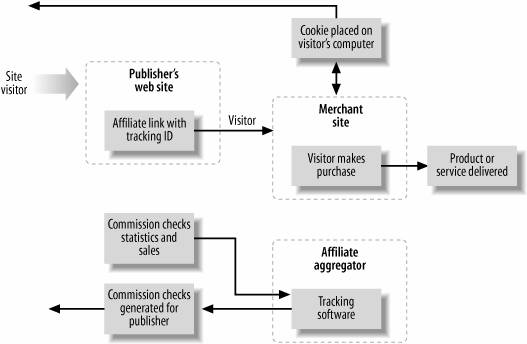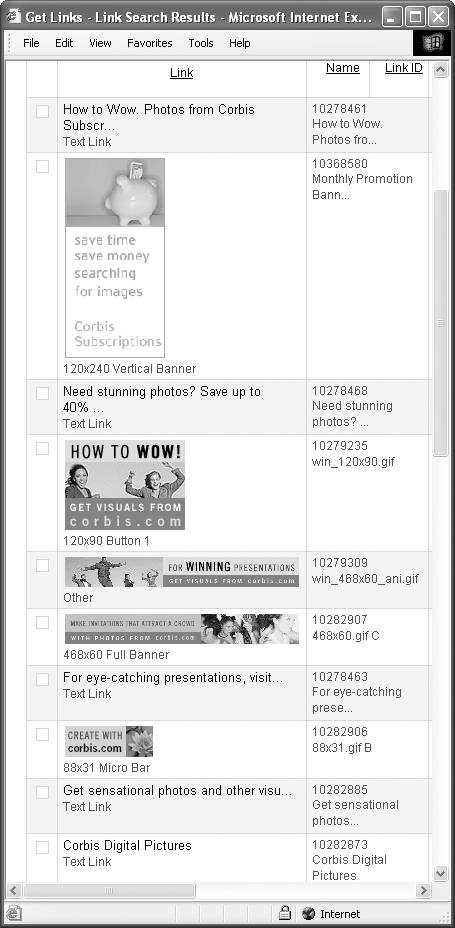Section 4.2. Understanding Affiliate Programs
4.2. Understanding Affiliate ProgramsAffiliate programs go by many names, including: "Affiliate marketing programs," "Virtual Marketing," "Revenue Sharing," "Associate Programs," "Internet Affiliate Marketing," "Direct Marketing," "Performance Marketing," "Partner Marketing," "Pay-For-Performance," and "Referral Programs." The names themselves give you an idea of what is involved. But as Shakespeare put it in Romeo and Juliet:
By whatever name it's called, an affiliate earns a commission from a merchant for generating a desired result. The specific result that must occur for the affiliate to earn a commission is (or should be) spelled out, and specified contractually, when the affiliate signs up for the program.
Most often, the event that leads to a commission for the affiliate is (as I've already stated) a merchant sale resulting from the affiliate's promotion. But this need not be the case. In some circumstances, providing a merchant with a qualified sales lead may be enough to generate a commission for the affiliate. Joining an affiliate program is potentially lucrative, but requires real attention and care. If not done right, you will not make any money from the affiliate programs you have joined. Unlike other forms of advertising on your site, you really should care about who your affiliate partners are. This is because you do not get paid unless the affiliate links on your side lead fairly directly to a sale (or other qualifying event). Understanding affiliate programs can be confusing: there's not a great deal of objective information available about this kind of advertising, affiliate aggregations sites are complex, and affiliate agreements are often full of legalese and opaque. But fear not! After reading this chapter, you'll have a pretty good idea of what affiliate programs are, how they work, and how you can craft an affiliate strategy that can help you make money from your web content. 4.2.1. Mechanics of the ProcessThere are a number of steps involved in the affiliate marketing process. Here's an overview:
Figure 4-1 shows how the affiliate marketing process works, assuming that the publisher has already been approved by the merchant and that a third-party aggregator actually tracks sales and commissions . Figure 4-1. Visitors link through the publisher's site to purchase from the merchant; a third-party aggregator tracks sales and commissions 4.2.2. CreativesBanners, buttons, and links provided by a merchant to an affiliate publisher are generally called creatives , a term deriving from the ad agency business. (Yes, I suppose it takes some creativity to make a good banner!) Creatives vary from fancy, splashy graphics made using Flash to simple text links pointing at a single product. There's a great variety in the kinds and sizes of creatives made available by merchants. To generalize, the most common kinds of creatives are:
Figure 4-2 shows some of the different creatives that are available to affiliates of the photo stock service Corbis. Figure 4-2. Merchants with good affiliate programs provide a wide choice in creatives, like this selection shown here from Corbis The best creative to use depends upon context and individual taste and what you think will work with visitors to your site. It's worth spending some time experimenting with different creatives to see if one performs better than another.
All creatives used in affiliate marketing provide a mechanism for including the tracking ID of the publisher, so the publisher can be credited for sales or other action events. Affiliate marketing works best when the merchant has high appeal to the demographics visiting a publisher's site (See "Matching affiliates with content," later in this chapter). In fact, some of the most effective affiliate links are simple text links to products that your content discusses or recommends. For example, a digital photography web site might well want to provide a link to a merchant partner selling a specific Nikon digital camera.
If you decide to use text links to product items, such as a Nikon D70 digital camera, eventually you'll probably need to understand where the merchant's tracking ID goes in the HTML used for a specific product link, as well as how to link to a specific product within a merchant's catalogue. For example, here's the code that Amazon.com provides as a text link to the Nikon D70 on Amazon.com (for more about Amazon and working with its creatives and links, See "The Amazon.com Associate Program," later in this chapter). <a href="http://www.amazon.com/exec/obidos/redirect?link_code=ur2 &camp=1789&tag=XXXXXXXXX &creative=9325&path=tg/detail/-/B0001LGDAO/"> Nikon D70</a> <img src="/books/2/226/1/html/2/http://www.assoc-amazon.com/e/ir?t=XXXXXXXXX&l=ur2&o=1" width="1" height="1" border="0" alt="" style="border:none !important; margin:0px !important;" />
The actual link that the Amazon.com code creates looks just like a normal text link, as you can see in Figure 4-3. Figure 4-3. These apparently normal links are actually creatives that embed an affiliate marketing tracking ID and point to a specific product on the site of the merchant (Amazon.com in this example)In the Nikon D70 example, the product is designated using its ASIN identification number, which is B0001LGDAO. As you can see, if you know a product's ASINwhich is easily available on the Amazon.com product pagesor, for books, the ISBN, you can easily construct your own affiliate links by hand. An interesting point is that you should understand where the graphic (usually a JPEG or GIF file) used in banner and button creatives is located. Amazon, as well as many other major affiliate merchants, hosts these graphics itself. Other programs ask you to copy graphics to your own web server. It's less trouble when the graphic is on the merchant's site, and it uses less of your own bandwidth, but if the merchant's server goes down, then your site looks (and is) broken . This happens more often than you might expect. True, if the merchant is not serving creatives, it is probably also not selling product, but if a graphic is missing from your site, it looks worse for you then if a link simply doesn't work. 4.2.3. Areas of ConcernThe relationship between a content web site and an affiliate advertiser is essentially like that of a commission-only sales rep to a manufacturer. You'll want to examine the same areas that a brick-and-mortar independent sales rep would look at before agreeing to carry a merchant's products. Start by asking these questions:
More specific to the Web, as I've mentioned in the context of hosting creatives, if a merchant's site goes down, then your links will be broken, and you won't be able to earn a commission. So you should feel reasonably good about the web site stability of a merchant whose affiliate program you join. As a Web "sales rep," you should also be concerned with (and investigate as thoroughly as possible) these issues:
Each of these points is worth some more discussion. 4.2.3.1. Amount of the commissionYou can (and should) find out the amount of the sales commission when you sign up for an affiliate program. There's a huge variety of commission structures, but you should probably expect a commission of between 3% and 10% of what the merchant receives, exclusive of shipping, handling, and sales tax.
You should take care to note precisely what action items trigger a sales commission. Most of the time, it is a sale. However, some sales may be excluded. In addition, some sites may pay commissions for qualified leadsfor example, someone signing up for a home mortgage and completing the paperworkwhether or not the product actually sells (with the mortgage example, refinancing wouldn't have to be completed for you to make your commission). Be on the lookout for commission structures that reward you for good performance. These kinds of programs can add bonus percentages to the commissions you make and can be quite rewarding if you deliver substantial traffic. In addition, some affiliate programs simply offer flat fees as incentives. For example, a web hosting affiliate program might pay affiliates $90 each time a visitor to the affiliate site signs up for a web hosting contract of a year or more.
Also note that, depending upon the program, commission payout usually does not take place right away. Most affiliate programs build some time in for product returns (or buyer's remorse). Once it is clear that there will not be any returns, it can still be 30 to 90 days before you are paid. 4.2.3.2. Sales and commission trackingSales and commission tracking is a serious issue. It's very important to most affiliate site publishers. If you don't know that transactions originating from your site are being consistently tracked, then you have no way to be assured that you will be paid the commissions you are owed. This implies that you should be careful to work only with third-party affiliate aggregators (See "Affiliate Aggregators," later in this chapter) or enroll in programs managed by an extremely reliable vendor, such as Amazon.com (See "The Amazon.com Associate Program," later in this chapter).
4.2.3.3. Merchant support of affiliate programsWill the merchant support your efforts with good promotions, incentives, and creatives? Ideally, an affiliate relationship is a long-term partnership. You'd like to know that the merchant supporting the affiliate program is in it for the long haul. Merchant support of affiliate programs makes a big difference in the following areas:
4.2.3.4. Matching affiliates with contentPerhaps the single biggest factor in successful affiliate marketing is the alignment of the content of your site with the affiliate merchant's offerings. In other words, visitors to your site should be genuinely interested in the products the merchant has to sell. You'll have a tough row to hoe if you try to sell cosmetics to visitors to a digital photography site, but should find it easier to sell these visitors digital photo equipment and processing services. Visitors to a site that provides technical services of use to webmasters are likely candidates for web hosting affiliate programs, but unlikely to buy lingerie or refrigerators. In the brick-and-mortar world, there used to be talk about a salesperson who could "sell ice to the Inuit." No web site can sell as well as this proverbial salesperson, so you need to use common sense and devise an intelligent strategy to provide affiliate links to products and services that are relevant to your site visitors. Relevant links get clicked, goods get purchased, and publishers get their commissions. More than any other form of web site advertising monetization, affiliate marketing requires careful honing of site content with an intelligent choice of partners and creatives. |
EAN: 2147483647
Pages: 145
